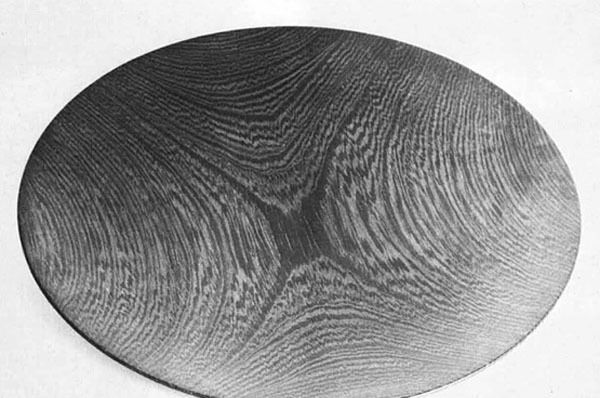
Synopsis: The author of this article keeps 20 tons of wood on hand from which to select for his projects. That is no typo. Bob Stocksdale, veteran woodturner and expert at selecting and using exotic wood, talks here about how he works, from hours and habits to machines and parts. He details dozens of wood types and shows photos of the bowls he’s made from them, including wenge, olivewood, shedua, ebony, cocobolo, and so many more.
I have three lathes—two Delta 12-inchers and a homemade big one that is built of steel I-beams and swings 31 inches inside the headstock. One of the Deltas has the headstock blocked up 3 inches so I can turn up to an 18-inch diameter inside. I do 90 percent of my turning on it as I have an exhaust fan just back of it to solve the dust problem. All three lathes have jackshafts for better speed selection. They also have reversing switches to aid in sanding.
Almost all of the decorative bowls, trays and smaller salad bowls are started on a single center screw or 6-inch faceplate. I use several different methods to do the inside job, sometimes even the single center screw, but more usually, for footed bowls, the three-jaw geared chuck. Trays usually have a block glued on the bottom, with newsprint between for easy removal.
I do most of my turning with two gouges, 1-inch and 1/2-inch standard tools of the kind also used for spindle work. The corners are ground back a long way so the tip is really a half-oval shape. I use a shearing cut. I never use the deep, long-and-strong style of gouge, because I don’t need all that metal, and there’s very little strain on the tool. In fact, I’d like to get some gouges made of steel that is only 1/8-inch thick, the ones I have are about 3/16.
Many, perhaps most of the deeper bowls have been roughed out first, dried in a heated room for about a month, then finished. The room is about 90 degrees, and I usually put a bowl on the floor for a week and then move it up onto the shelves for three weeks and it’s dry. I have very little cracking and checking. When cracking does occur, I rough-sand the bowl and then repair it with a mixture of liquid epoxy and sawdust, as much sawdust as the epoxy will take. It sets overnight and you can turn right through it.
From Fine Woodworking #4
For the full article, download the PDF below:
Fine Woodworking Recommended Products

CrushGrind Pepper Mill Mechanism

Drafting Tools

DeWalt 735X Planer




















Log in or create an account to post a comment.
Sign up Log in